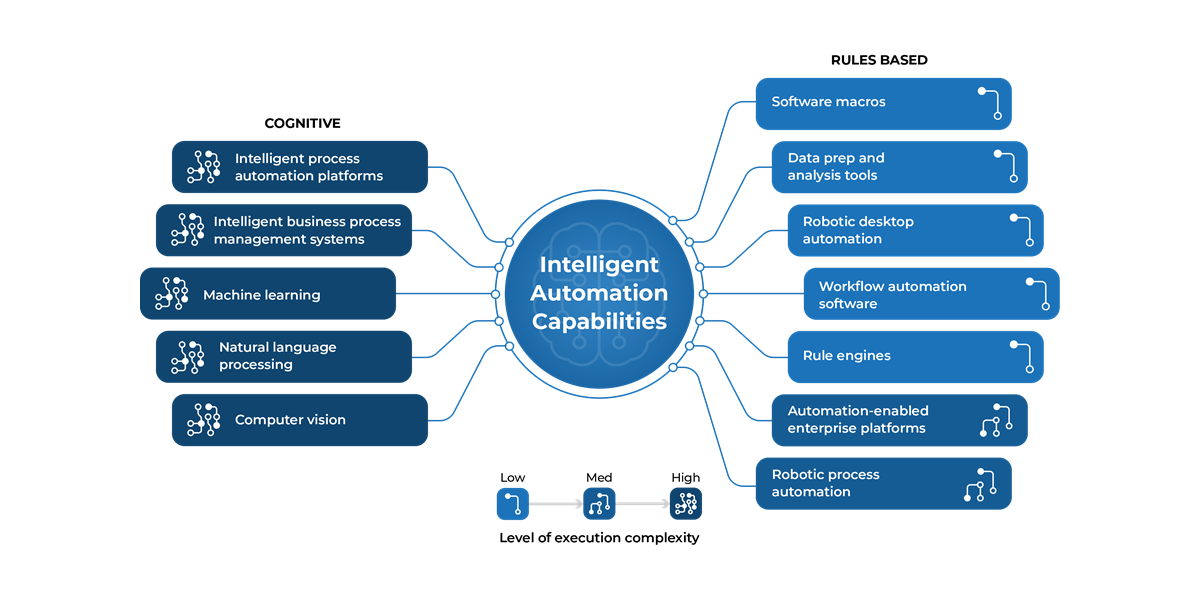Organizations are harnessing automation to improve business process speed, accuracy, and efficiency. Automation can also lend a helping hand with employee morale and patient satisfaction when it eliminates mundane tasks and increases accessibility, respectively.
Choosing the right automation tool is just as important as selecting the right process to transform. An organization should choose an automation tool only after it thoroughly understands and optimizes a process. Your unique process requirements should determine the automation tool—not the other way around. You shouldn’t select a tool and force a process to adapt.
Automation tools vary quite a bit in complexity and function depending on the need. For example, assembly lines often use basic rule-based robotics for repetitive work—one machine performs one simple task over and over. Each action requires a separate machine. Cognitive-based automation conduct more complex tasks, and often more than one task. And within those two broad categories lies other variations. Organizations can use a variety of automation types depending on their needs.

“We can relate different types of automation to different parts of the human body with similar functions: RPA is like hands; OCR like eyes; NLP like ears and mouth; and ML as a brain.”
- Prashant Krishnakumar, Genzeon VP of Intelligent Automation
Different Types of Rule-Based and Cognitive-Based Automation
Rule-Based Automation
Businesses have been using rule-based automation for decades. As the name suggests, this type of system uses specific rules to conduct simple functions, a structure known as “if-this-then-that.” For example: “If the email contains ‘@QuestDiagnostics,’ domain, then it is transferred to ‘lab results’ folder.”
Rule-based automation cannot perform tasks outside their strict rules. Any variation or exception must be written as an additional rule. This type of automation can be quite easy and efficient to develop and maintain, and can often be modified by an IT professional or business analyst without programming. Organizations often use three common types of rule-based systems:
- Robotic process automation (RPA)
- Macro
- Optical character recognition (OCR)
Robotics Process Automation (RPA)
Robotics process automation uses software “robots” driven by low-code, ruled-based scripts to automate simplistic, repetitive, and often time-consuming tasks. Automating these processes helps organizations relieve employees of menial duties and opens their schedules for more complex, higher-functioning responsibilities—therein boosting employee satisfaction, engagement, and productivity. As it streamlines workflows, it inspires profitability and other positive business outcomes.
The software is noninvasive and typically low-code, so it’s easy to build, deploy, and manage. It’s ideal for automating workflows that involve legacy systems that lack APIs, virtual desktop infrastructures (VDIs), or database access.
Macro
A macro is an automated series of commands that can be used to imitate keystrokes or mouse actions. They’re typically used to perform repetitive computer input, such as when entering data into a spreadsheet or word processing applications, like Microsoft Word and Excel.
Optical Character Recognition (OCR)
Optical Character Recognition recognizes text with a digital image, such as detecting text in scanned documents. Organizations can use OCR to create electronic versions of physical paper documents.
Cognitive-Based
Cognitive-based automation takes RPA beyond the basics. This higher-level automation tackles more complex tasks using various combinations of technologies, including RPA, machine learning (ML), natural language processing (NLP), and optical character recognition (OCR).
Intelligent virtual assistants (IVAs) are an excellent example of this emerging technology, as we see IVAs beginning to replace rudimentary chatbots. Where chatbots are restricted to simple, pre-programmed scripts to imitate human communication, IVAs harness IA to learn and facilitate natural, more human-like dialogue that hasn’t been programmed. This is only one sampling of IA’s power to further refine organizations’ processes and enhance customer interaction.
Natural language processing and machine learning are two types of cognitive-based technology.
Natural Language Processing
Natural language processing grants computers the ability to interpret human language, both written and voice data. But not only can this form of cognitive technology learn language, it has the potential for sentiment analysis—interpreting subjective qualities within language, such as emotions, sarcasm, and attitudes.
NLP integrates ruled-based modeling of human language (computational linguistics) with machine learning. It can be used for speech recognition and response, language translation, and automatic text summarization. Chatbots, cell phone speech-to-text, and voice-operated GPS systems are just a few examples of NLP in action.
Machine Learning
Machine learning systems possess the ability to learn and adapt from past ‘experiences’ without specific programming or following strict instructions like RPA. This technology uses statistical models and algorithms to analyze and recognize patterns, learning and adapting over time—much like a human would learn a new skill or language.
Machine learning can improve NLP in delivering more accurate responses and work well for automation programs where rules or algorithms need to be more complex. This form of cognitive technology requires less human interaction than RPA but requires heavier processing.
Automation has bestowed abundant rewards to humans over the past several decades. It has accelerated manufacturing, assisted in the operating room, and shown us images from space. And now, businesses are harnessing the power of automation to improve efficiency and accuracy and relieve employees from dull, repetitive tasks. Of course, people will always be needed to manage the machines and take over when technology fails or a human touch is required, but a balance of the right technology and human interaction can amplify a company’s potential.
To dive deeper into business process automation and how your organization can benefit, visit Genzeon.



